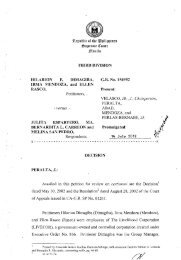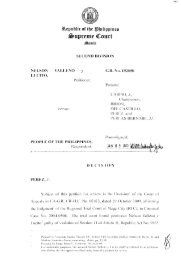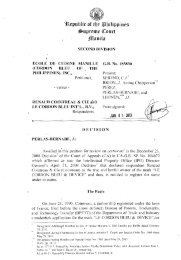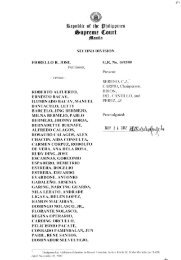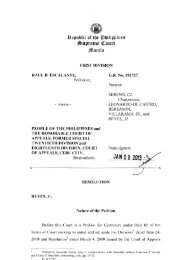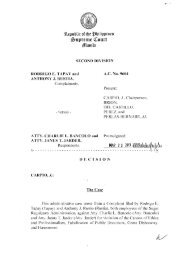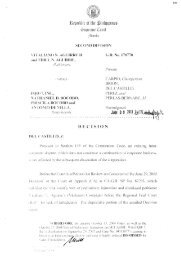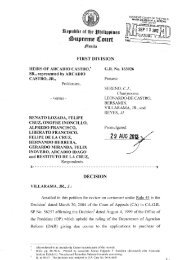G.R. No. 195518. March 20, 2013 - Supreme Court of the Philippines
G.R. No. 195518. March 20, 2013 - Supreme Court of the Philippines
G.R. No. 195518. March 20, 2013 - Supreme Court of the Philippines
Create successful ePaper yourself
Turn your PDF publications into a flip-book with our unique Google optimized e-Paper software.
3Republic <strong>of</strong> tbe 1J3biltppines~upreme QI:ourt;ifflanHaTHIRD DIVISIONMAGSA YSA Y MARITIMESERVICES and PRINCESSCRUISE LINES, LTD.,Petitioners,-versus-G.R. <strong>No</strong>. 195518Present:VELASCO, JR., J, Chairperson,PERALTA,ABAD,MENDOZA, andLEONEN,JJEARL WIN MEINRADPromulgated:ANTERO F. LAUREL, /lf .YRespondent. <strong>March</strong> <strong>20</strong>, <strong>20</strong>13 _ ;1'6~)( ------------------------------------------------------------------------~---- )(DECISIONMENDOZA, J.:This is a petition tor review on certiorari under Rule 45 <strong>of</strong> <strong>the</strong>Revised Rules <strong>of</strong> <strong>Court</strong> assailing <strong>the</strong> August 6, <strong>20</strong>10 Decision 1 and <strong>the</strong>February 4, <strong>20</strong>11 Resolution 2 <strong>of</strong><strong>the</strong> <strong>Court</strong><strong>of</strong> Appeals (CA), in CA-G.R. SP<strong>No</strong>. 102130 entitled Magsaysay Maritime Services and Princess CruiseLines, Ltd. v. National Labor Relations Commission and Ear/win MeinradAntero F. Laurel, affirming <strong>the</strong> September 17, <strong>20</strong>07 Decision 3 <strong>of</strong> <strong>the</strong>National Labor Relations Commission (NLRC).The FactsRespondent Earlwin l\1einrad Antero F. Laurel (Laurel) wasemployed by petitioner Princess Cruise Lines, Ltd., through its local1Annex "A" <strong>of</strong> Petition, ro!/u, pp. 60-68. Penned by Associate Justice Mario L. Guarina III with AssociateJustice Apolinario D. Bruselas, Jr. and Associate .Justice Rodil V. Zalameda, concurring.2Annex "C" <strong>of</strong> Petition, id. at 94.1Records, pp. 56-6 i.,,
DECISION 2G.R. <strong>No</strong>. 195518manning agency, petitioner Magsaysay Maritime Corporation, as secondpastryman on board <strong>the</strong> “M/V Star Princess.” In June <strong>20</strong>04, <strong>the</strong>y executed aPhilippine Overseas Employment Agency (POEA)-approved Contract <strong>of</strong>Employment 4 embodying <strong>the</strong> Standard Terms and Conditions Governing <strong>the</strong>Employment <strong>of</strong> Filipino Seafarers On Board Ocean-Going Vessels andstating in particular <strong>the</strong> terms <strong>of</strong> his employment. Laurel underwent a preemploymentmedical examination at <strong>the</strong> petitioner company’s accreditedclinic in Makati and was declared fit for sea service. He was deployed inAugust <strong>20</strong>04 to join <strong>the</strong> assigned vessel. 5In <strong>the</strong> course <strong>of</strong> <strong>the</strong> voyage, Laurel fell ill. He complained <strong>of</strong> feverwith cough, and he was given paracetamol until reaching <strong>the</strong> shore. OnApril 3, <strong>20</strong>05, he disembarked from <strong>the</strong> vessel and proceeded to a hospital inFlorida, U.S.A. Due to <strong>the</strong> persistence <strong>of</strong> his illness, he was repatriated forfur<strong>the</strong>r evaluation. He arrived in <strong>the</strong> <strong>Philippines</strong> on April 7, <strong>20</strong>05. 6On April 8, <strong>20</strong>05, Laurel was admitted to <strong>the</strong> Metropolitan Hospital inManila, placed under <strong>the</strong> medical care <strong>of</strong> Dr. Robert Lim, and diagnosedwith upper respiratory tract infection and hyperthyroidism. He wasdischarged on April 11, <strong>20</strong>05 and was prescribed take-home medications. 7Dr. Mylene Cruz-Balbon, <strong>the</strong> hospital’s assistant medicalcoordinator, issued a medical report, 8 dated April 11, <strong>20</strong>05, confirming thatLaurel was suffering from hyperthyroidism and that he was started on antithyroidmedication. It was indicated in <strong>the</strong> said medical report thathyperthyroidism, an overactivity <strong>of</strong> <strong>the</strong> thyroid gland usually secondary toan immunologic reaction, was not work-related.On April 25, <strong>20</strong>05, during his last follow-up at <strong>the</strong> petitionercompany’s medical facility, Laurel was already asymptomatic for upperrespiratory tract infection. As he no longer had fever, cough and cold, hewas cleared <strong>of</strong> his pulmonary problem. He was advised to consult aninternist on his own account with regard to his hyperthyroidism as thisillness was allegedly not work-related. 9When Laurel returned to his hometown <strong>of</strong> Naga City, he consultedDr. Ramon Caceres (Dr. Caceres), an endocrinologist. On January 21,<strong>20</strong>06, Dr. Caceres issued a medical certificate attesting that he was treatedfor Euthyroid Graves’ Disease. By <strong>the</strong>n, he was clinically and4 Id. at 119.5 Rollo, p. 60.6 Id. at 61.7 Id.8 Records, pp. 100-101.9 Rollo, p. 61.
DECISION 3G.R. <strong>No</strong>. 195518biochemically euthyroid. His oral anti-thyroid medications were tapered <strong>of</strong>ffor possible discontinuation <strong>of</strong> treatment. 10On August 3, <strong>20</strong>06, Laurel filed a complaint 11 against <strong>the</strong> petitionersbefore <strong>the</strong> NLRC, claiming medical reimbursement, sickness allowance,permanent disability benefits, damages, and attorney’s fees.Thereafter, Laurel returned to Dr. Caceres for a more extensivediagnosis. On August 12, <strong>20</strong>06, he obtained a medical certificate 12 with<strong>the</strong>se findings – Stage 1B diffuse goiter, recurrent periodic paralysis <strong>of</strong>lower extremities Wayne’s Index to 27 points, and hyperthyroid TFT’s(suppressed TSH, elevated T3). Dr. Caceres diagnosed Laurel’s illness asGraves’ Disease (hyperthyroidism stage 1B diffuse goiter) with periodicparalysis. He was advised not to undergo strenuous activity as it wasdangerous for him to ambulate given his unpredictable episodes <strong>of</strong> paralysis.His illness was described as equivalent to Grave 1 impediment. 13The petitioners opposed Laurel’s claims, contending that his illnesshad been categorically determined as not work-related.The Labor Arbiter’s DecisionThe Labor Arbiter (LA), in a Decision, 14 dated February 1, <strong>20</strong>07,dismissed <strong>the</strong> complaint. The LA held that Laurel was not entitled to hisclaims, with his hyperthyroidism having been found as not work-related bypetitioner’s company physician. The LA reasoned out that under <strong>the</strong> POEA-Standard Employment Contract (SEC), <strong>the</strong> employer was liable for <strong>the</strong>payment <strong>of</strong> disability benefits only for work-related illnesses sustainedduring <strong>the</strong> term <strong>of</strong> <strong>the</strong> contract and after determination <strong>of</strong> correspondingimpediment grade by <strong>the</strong> company-designated physician. According to <strong>the</strong>LA, hyperthyroidism was not listed in Section 32 <strong>of</strong> POEA-SEC as acompensable occupational disease, and Laurel was not able to discharge hisburden <strong>of</strong> proving that his illness was work-related or work-aggravated.The NLRC RulingOn appeal, <strong>the</strong> NLRC reversed <strong>the</strong> LA decision and awardeddisability compensation in favor <strong>of</strong> Laurel. It found that <strong>the</strong> illness waswork-related for failure <strong>of</strong> <strong>the</strong> petitioners to overcome <strong>the</strong> presumptionprovided under <strong>the</strong> POEA-SEC that an illness occurring during <strong>the</strong>10 Id. at 62.11 Records, pp. 135-136.12 Records, p. 134.13 Rollo, p. 62.14 Records, pp. 69-76.
DECISION 4G.R. <strong>No</strong>. 195518employment, even if not listed, was work-related. The NLRC added thatunder <strong>the</strong> said contract, <strong>the</strong> petitioners had <strong>the</strong> legal obligation tocompensate Laurel for his incapability to continue his job due to his illness.Citing Philippine Transmarine Carriers, Inc. v. NLRC, 15 it held that it wasnot <strong>the</strong> illness which was being compensated, but ra<strong>the</strong>r <strong>the</strong> incapacity towork resulting in <strong>the</strong> impairment <strong>of</strong> his earning capacity. Finally, <strong>the</strong> NLRCpointed out that for a claimant to be entitled to disability benefits, it was notrequired that <strong>the</strong> employment be <strong>the</strong> sole cause <strong>of</strong> <strong>the</strong> illness. It was enoughthat <strong>the</strong> employment had contributed, even in a small degree, to <strong>the</strong>development <strong>of</strong> <strong>the</strong> disease. The NLRC disposed <strong>of</strong> <strong>the</strong> case as follows:WHEREFORE, <strong>the</strong> foregoing premises considered, <strong>the</strong>instant appeal is hereby GRANTED.Accordingly, <strong>the</strong> decision appealed from is REVERSED andSET ASIDE, and a new one is issued ordering respondentMagsaysay Maritime Services and/or Agripito Milano, Jr. to pay <strong>the</strong>disability benefits <strong>of</strong> Earlwin Meinrad Antero F. Laurel in <strong>the</strong>amount <strong>of</strong> US$60,000.00 or in Philippine Currency at <strong>the</strong>conversion rate prevailing at <strong>the</strong> time <strong>of</strong> payment.SO ORDERED. 16 [Emphasis in <strong>the</strong> original]The CA DecisionAfter <strong>the</strong>ir motion for reconsideration was denied, <strong>the</strong> petitionerselevated <strong>the</strong> case to <strong>the</strong> CA through a petition for certiorari. The CA,however, dismissed <strong>the</strong> petition and sustained <strong>the</strong> award <strong>of</strong> disabilitybenefits in favor <strong>of</strong> Laurel. It held that <strong>the</strong> NLRC did not commit a graveabuse <strong>of</strong> discretion in ordering <strong>the</strong> payment <strong>of</strong> disability benefits to Laurel. 17The CA explained that although <strong>the</strong> petitioners’ medical literaturespoke <strong>of</strong> hyperthyroidism as hereditary, it also alluded to <strong>the</strong> triggers <strong>of</strong> <strong>the</strong>disease and cited that stress could also be a trigger. The CA concluded thatstressful conditions could result in, or could be a factor in, <strong>the</strong> emergence <strong>of</strong>hyperthyroidism. It found that <strong>the</strong> working conditions on board <strong>the</strong> MV StarPrincess had contributed and aggravated <strong>the</strong> illness <strong>of</strong> Laurel. This,according to <strong>the</strong> CA, was sufficient to entitle him to disability benefits.15 405 Phil. 487, 494 (<strong>20</strong>01).16 Records, pp. 60-61.17 Rollo, p. 67.
DECISION 5G.R. <strong>No</strong>. 195518The petitioners filed a motion for reconsideration 18 <strong>of</strong> <strong>the</strong> saiddecision, but it was denied by <strong>the</strong> CA in its February 4, <strong>20</strong>11 Resolution.Hence, <strong>the</strong> petitioners interpose this petition before this <strong>Court</strong>anchored on <strong>the</strong> followingGROUNDSThe Honorable <strong>Court</strong> <strong>of</strong> Appeals erred in affirming <strong>the</strong>Decision <strong>of</strong> <strong>the</strong> NLRC, awarding total and permanentdisability compensation to Respondent. Respondent is notentitled to any disability compensation as his illness is notwork-related. The POEA Standard Employment Contractclearly states that only those work-related illnesses orinjuries which were suffered during <strong>the</strong> term <strong>of</strong> <strong>the</strong>employment contract are compensable.The Honorable <strong>Court</strong> <strong>of</strong> Appeals erred in holding thatPetitioners failed to overcome <strong>the</strong> presumption <strong>of</strong>compensability. The <strong>Supreme</strong> <strong>Court</strong> has consistently heldthat it is <strong>the</strong> complainant (herein Respondent) who has <strong>the</strong>burden to prove entitlement to disability benefits.I.II.III.The Honorable <strong>Court</strong> <strong>of</strong> Appeals erred in not upholding <strong>the</strong>findings and assessment <strong>of</strong> <strong>the</strong> company-designatedphysician. The POEA Standard Employment Contractstates that it is <strong>the</strong> company-designated physician who istasked to assess a seafarer’s condition and determine hisdisability, if any. Thus, <strong>the</strong> company-designated physician’sdeclaration concerning Respondent’s state <strong>of</strong> health bindshim. 19Petitioners’ ArgumentThe petitioners argue that <strong>the</strong> CA erred in affirming <strong>the</strong> award <strong>of</strong>disability benefits to Laurel because his illness was not work-related asconvincingly proven through <strong>the</strong> expert opinion <strong>of</strong> <strong>the</strong> company-designated18 Annex “B” <strong>of</strong> Petition, id. at 69-89.19 Id. at 32.
DECISION 6G.R. <strong>No</strong>. 195518physician. They insist that <strong>the</strong>ir doctor’s assessment should have beenaccorded weight and credence considering his detailed knowledge <strong>of</strong>, andhis familiarity with, Laurel’s condition and <strong>the</strong> extensive medical attentiongiven to him. They aver that hyperthyroidism is not among those listed in<strong>the</strong> POEA-SEC as an occupational disease, hence, not compensable. Theyemphasize that Laurel’s illness was essentially genetic and was not causedby his employment. Citing jurisprudence, <strong>the</strong> petitioners assert that <strong>the</strong>burden is placed upon <strong>the</strong> seafarer to substantiate his claim that <strong>the</strong> illness iswork-related and to prove that <strong>the</strong>re is a connection between his employmentand his illness. Laurel presented no substantial pro<strong>of</strong> that hishyperthyroidism was caused or aggravated by <strong>the</strong> working conditions onboard MV Star Princess.Respondent’s PositionLaurel, in his Compliance and Manifestation with Comment toPetitioners’ Petition for Review on Certiorari, <strong>20</strong> counters that his illness iscompensable because it was acquired during <strong>the</strong> effectivity <strong>of</strong> hisemployment contract while performing his work aboard <strong>the</strong> petitioners’vessel. The fact that Grave’s Disease may be hereditary does not bar himfrom entitlement to disability benefits. Compensability does not require thatemployment be <strong>the</strong> sole cause <strong>of</strong> <strong>the</strong> illness. It is enough that <strong>the</strong>re exists areasonable work connection. The strenuous condition <strong>of</strong> his employment onboard <strong>the</strong> MV Star Princess triggered <strong>the</strong> development <strong>of</strong> hishyperthyroidism due to his exposure to varying temperature and chemicalirritants. Contrary to <strong>the</strong> petitioners’ contention, Laurel asserts that <strong>the</strong>burden <strong>of</strong> pro<strong>of</strong> rests on <strong>the</strong> petitioners by virtue <strong>of</strong> <strong>the</strong> presumption <strong>of</strong>compensability under Section 32 <strong>of</strong> <strong>the</strong> POEA contract.Laurel likewise contends that <strong>the</strong> jurisdiction <strong>of</strong> <strong>the</strong> <strong>Court</strong> in casesbrought before it from <strong>the</strong> CA by way <strong>of</strong> petition for review on certiorariunder Rule 45 <strong>of</strong> <strong>the</strong> Revised Rules <strong>of</strong> <strong>Court</strong> is limited to reviewing errors <strong>of</strong>law, and that findings <strong>of</strong> fact <strong>of</strong> <strong>the</strong> latter are conclusive. Specifically,Laurel cited <strong>the</strong> case <strong>of</strong> Palomado v. National Labor RelationsCommission, 21 in stating <strong>the</strong> fundamental rule that <strong>the</strong> factual findings <strong>of</strong>quasi-judicial agencies like <strong>the</strong> NLRC if supported by substantial evidenceare generally accorded not only great respect but even finality, and arebinding upon <strong>the</strong> <strong>Court</strong>, unless <strong>the</strong> petitioner is able to show that <strong>the</strong> NLRCarbitrarily disregarded evidence before it or misapprehended evidence tosuch an extent as to compel a contrary conclusion if such evidence were tobe properly appreciated. In this case, according to him, <strong>the</strong> CA correctlyaffirmed <strong>the</strong> finding <strong>of</strong> <strong>the</strong> NLRC that Laurel was entitled to disabilitycompensation and o<strong>the</strong>r charges.<strong>20</strong> Id. at 102-114.21 327 Phil. 472, 483 (1996).
DECISION 7G.R. <strong>No</strong>. 195518The <strong>Court</strong>’s RulingA perusal <strong>of</strong> <strong>the</strong> petitioners’ arguments discloses that <strong>the</strong> issues raisedare essentially factual in nature. Generally, factual issues are not propersubjects <strong>of</strong> <strong>the</strong> <strong>Court</strong>’s power <strong>of</strong> judicial review.It is elementary that this <strong>Court</strong> is not a trier <strong>of</strong> facts and this ruleapplies with greater force in labor cases. Questions <strong>of</strong> fact are for <strong>the</strong> labortribunals to resolve. Only errors <strong>of</strong> law are generally reviewed in petitionsfor review on certiorari criticizing <strong>the</strong> decisions <strong>of</strong> <strong>the</strong> CA. Indeed, findings<strong>of</strong> fact <strong>of</strong> quasi-judicial bodies like <strong>the</strong> NLRC, as affirmed by <strong>the</strong> CA, aregenerally conclusive on this <strong>Court</strong>. In exceptional cases, however, <strong>the</strong> <strong>Court</strong>may be urged to probe and resolve factual issues when <strong>the</strong>re is insufficientor insubstantial evidence to support <strong>the</strong> findings <strong>of</strong> <strong>the</strong> tribunal or <strong>the</strong> courtbelow, or when too much is concluded, inferred or deduced from <strong>the</strong> bare orincomplete facts submitted by <strong>the</strong> parties or, where <strong>the</strong> LA and <strong>the</strong> NLRCcame up with conflicting positions. 22 The present case clearly falls within<strong>the</strong>se exceptions as <strong>the</strong> finding <strong>of</strong> <strong>the</strong> LA, on one hand, conflicts with those<strong>of</strong> <strong>the</strong> NLRC and <strong>the</strong> CA, on <strong>the</strong> o<strong>the</strong>r.The <strong>Court</strong>, never<strong>the</strong>less, finds for respondent Laurel, and resolves thathis hyperthyroidism is compensable.The POEA-SEC, as provided under Department Order <strong>No</strong>. 4, series <strong>of</strong><strong>20</strong>00 <strong>of</strong> <strong>the</strong> Department <strong>of</strong> Labor and Employment, which contains <strong>the</strong>Standard Terms and Conditions Governing The Employment <strong>of</strong> FilipinoSeafarers On-Board Ocean-Going Vessels, governs <strong>the</strong> employment contractbetween Laurel and <strong>the</strong> petitioners. POEA came out with it pursuant to itsmandate under Executive Order (E.O.) <strong>No</strong>. 247 23 to "secure <strong>the</strong> best termsand conditions <strong>of</strong> employment <strong>of</strong> Filipino contract workers and ensurecompliance <strong>the</strong>rewith" and to "promote and protect <strong>the</strong> well-being <strong>of</strong>Filipino workers overseas." 24 Section <strong>20</strong>-B <strong>of</strong> <strong>the</strong> POEA-SEC enumerates<strong>the</strong> duties <strong>of</strong> an employer to his employee who suffers work-related diseaseor injury during <strong>the</strong> term <strong>of</strong> his employment contract, to quote:Section <strong>20</strong> (B)COMPENSATION AND BENEFITS FOR INJURY OR ILLNESS22 Andrada v. Agemar Manning Agency, Inc., G.R. <strong>No</strong>. 194758, October 24, <strong>20</strong>12.23 Reorganizing <strong>the</strong> Philippine Overseas Employment Administration and for O<strong>the</strong>r Purposes, dated July21, 1987.24 Fil-Star Maritime Corporation v. Rosete, G.R. <strong>No</strong>. 192686, <strong>No</strong>vember 23, <strong>20</strong>11, 661 SCRA 247, 254,citing Secs. 3(i) and (j) <strong>of</strong> E.O. <strong>No</strong>. 247.
DECISION 8G.R. <strong>No</strong>. 195518The liabilities <strong>of</strong> <strong>the</strong> employer when <strong>the</strong> seafarer suffers workrelatedinjury or illness during <strong>the</strong> term <strong>of</strong> his contract are asfollows:x x x x6. In case <strong>of</strong> permanent total or partial disability <strong>of</strong> <strong>the</strong> seafarercaused by ei<strong>the</strong>r injury or illness <strong>the</strong> seafarer shall be compensatedin accordance with <strong>the</strong> schedule <strong>of</strong> benefits enumerated in Section32 <strong>of</strong> this Contract. Computation <strong>of</strong> his benefits arising from anillness or disease shall be governed by <strong>the</strong> rates and rules <strong>of</strong>compensation applicable at <strong>the</strong> time <strong>the</strong> illness or disease wascontracted.Pursuant to <strong>the</strong> aforequoted provision, two elements must concur foran injury or illness <strong>of</strong> a seafarer to be compensable. First, <strong>the</strong> injury orillness must be work-related; and second, that <strong>the</strong> work-related injury orillness must have existed during <strong>the</strong> term <strong>of</strong> <strong>the</strong> seafarer’s employmentcontract. 25 Both requisites obtain in this case.For disability to be compensable under Section <strong>20</strong> (B) <strong>of</strong> <strong>the</strong> <strong>20</strong>00POEA-SEC, it must be <strong>the</strong> result <strong>of</strong> a work-related injury or a work-relatedillness, which are defined as "injury(ies) resulting in disability or deatharising out <strong>of</strong> and in <strong>the</strong> course <strong>of</strong> employment" and as "any sicknessresulting to disability or death as a result <strong>of</strong> an occupational disease listedunder Section 32-A <strong>of</strong> this contract with <strong>the</strong> conditions set <strong>the</strong>rein satisfied."Section 32-A. OCCUPATIONAL DISEASESFor an occupational disease and <strong>the</strong> resulting disability or death tobe compensable, all <strong>of</strong> <strong>the</strong> following conditions must be satisfied:1. The seafarer’s work must involve <strong>the</strong> risks described herein;2. The disease was contracted as a result <strong>of</strong> <strong>the</strong> seafarer’s exposureto <strong>the</strong> described risks;3. The disease was contracted within a period <strong>of</strong> exposure andunder such o<strong>the</strong>r factors necessary to contract it;4. There was no notorious negligence on <strong>the</strong> part <strong>of</strong> <strong>the</strong> seafarer.As borne by <strong>the</strong> records, Laurel was afflicted with hyperthyroidismduring <strong>the</strong> term <strong>of</strong> his employment contract that caused his discharge formedical examination in Florida, U.S.A. on April 3, <strong>20</strong>05 and his subsequentrepatriation to <strong>the</strong> <strong>Philippines</strong>.25 Jebsens Maritime Inc. v. Undag, G.R. <strong>No</strong>. 191491, December 14, <strong>20</strong>11, 662 SCRA 670, 677.
DECISION 9G.R. <strong>No</strong>. 195518Hyperthyroidism is <strong>the</strong> medical term to describe <strong>the</strong> signs andsymptoms associated with an overproduction <strong>of</strong> thyroid hormones. It is acondition in which <strong>the</strong> thyroid gland makes too much thyroid hormonesaffecting <strong>the</strong> tissues <strong>of</strong> <strong>the</strong> body. 26 Although <strong>the</strong>re are several causes <strong>of</strong>hyperthyroidism, most <strong>of</strong> <strong>the</strong> symptoms patients experience are <strong>the</strong> sameregardless <strong>of</strong> <strong>the</strong> cause. Because <strong>the</strong> body's metabolism is increased,patients <strong>of</strong>ten feel hotter than those around <strong>the</strong>m and can slowly lose weighteven though <strong>the</strong>y may be eating more. The weight issue is confusingsometimes since some patients actually gain weight because <strong>of</strong> an increasein <strong>the</strong>ir appetite. Patients with hyperthyroidism usually experience fatigue at<strong>the</strong> end <strong>of</strong> <strong>the</strong> day, but have trouble sleeping. Trembling <strong>of</strong> <strong>the</strong> hands and ahard or irregular heartbeat (called palpitations) may develop. Theseindividuals may become irritable and easily upset. When hyperthyroidism issevere, patients can suffer shortness <strong>of</strong> breath, chest pain and muscleweakness. 27The most common underlying cause <strong>of</strong> hyperthyroidism is Graves'Disease. It is classified as an autoimmune disease, caused by <strong>the</strong> patient'sown immune system turning against <strong>the</strong> patient's own thyroid gland. Thehyperthyroidism <strong>of</strong> Graves' Disease, <strong>the</strong>refore, is caused by antibodies that<strong>the</strong> patient's immune system makes. The antibodies attach to specificactivating sites on <strong>the</strong> thyroid gland and those, in turn, cause <strong>the</strong> thyroid tomake more hormones. 28Stress is a factor that appears to trigger <strong>the</strong> onset <strong>of</strong> Graves'Disease. Researchers have documented a definite connection between majorlife stressors and <strong>the</strong> onset <strong>of</strong> Graves' disease. 29 Lifestyle factors are perhaps<strong>the</strong> biggest factor that lead to a hyperthyroid condition. Two <strong>of</strong> <strong>the</strong> biggestlifestyle factors are chronic stress and poor eating habits. There are o<strong>the</strong>rrisk factors for <strong>the</strong> disorder. Based on family and twin studies, geneticfactors are important. Postulated environmental and lifestyle risk factorsinclude cigarette smoking, stress and adverse life events, and high dietaryiodine intake. 30 With regard to stress, while <strong>the</strong>re is nothing that can be doneto entirely eliminate it in people’s lives, most can do a much better job inhandling it. Too much stress can create problems with <strong>the</strong> adrenalglands, as while <strong>the</strong>y are designed to handle acute stress situations, <strong>the</strong>ycannot adequately handle chronic, prolonged stress. Problems with <strong>the</strong>26 http://www.endocrineweb.com/conditions/hyperthyroidism/hyperthyroidism-overactivity-thyroid-gland-0; last visited <strong>March</strong> 15, <strong>20</strong>13.27 http://www.endocrineweb.com/conditions/hyperthyroidism/hyperthyroidism-overactivity-thyroid-gland-028 http://www.endocrineweb.com/conditions/hyperthyroidism/hyperthyroidism-overactivity-thyroid-gland-129 http://thyroid.about.com/od/hyperthyroidismgraves/a/risks-symptoms.htmRisks and Symptoms <strong>of</strong> Graves'Disease and Hyperthyroidism. By Mary Shomon, About.com Guide. Updated June 17, <strong>20</strong>08.30 http://archinte.jamanetwork.com/article.aspx?articleid=486661.
DECISION 10G.R. <strong>No</strong>. 195518adrenal glands will eventually affect o<strong>the</strong>r areas <strong>of</strong> <strong>the</strong> body, including <strong>the</strong>thyroid gland. 31 [Emphases supplied]Laurel, in his Memorandum, 32 aptly explained how stress can lead to athyroid condition, to quote:‘It’s important to understand that our bodies weren’tdesigned to handle chronic stress. The adrenal glands weredesigned to handle acute stress situations without much <strong>of</strong> aproblem. But in today’s world most people are overwhelmed withstressful situations, as <strong>the</strong>y have stressful jobs, stressfulrelationships, financial issues, and many issues that lead to chronicstress. Since <strong>the</strong> adrenal glands weren’t designed to handle chronicstress situations, what happens is that for a person who deals with alot <strong>of</strong> stress AND does a poor job <strong>of</strong> managing it, over a period <strong>of</strong>months and years <strong>the</strong>ir adrenal glands will weaken, which caneventually lead to adrenal fatigue. But even before <strong>the</strong>se glandsreach this point, this can create o<strong>the</strong>r problems, includingdysfunction <strong>of</strong> <strong>the</strong> thyroid gland.The way that stressed out adrenals can cause thyroidmalfunction is <strong>the</strong> following: when <strong>the</strong> adrenal glands are stressedout, it puts <strong>the</strong> body in a state <strong>of</strong> catabolism, which means that <strong>the</strong>body is breaking down. Because <strong>of</strong> this, <strong>the</strong> body will slow down<strong>the</strong> thyroid gland as a protective mechanism. The reason behindthis is because <strong>the</strong> thyroid gland controls <strong>the</strong> metabolism <strong>of</strong> <strong>the</strong>body, and so <strong>the</strong> body slows it down in order to slow down <strong>the</strong>catabolic process. This is why many times <strong>the</strong> thyroid gland won’trespond to treatment until you address <strong>the</strong> adrenal glands.If <strong>the</strong> adrenal glands are not addressed, this can affect o<strong>the</strong>rbodily systems. For example, someone with weak adrenal glandswho has a thyroid disorder can develop a compromised immunesystem. This eventually can lead to an autoimmune thyroiddisorder, such as Graves’ Disease or Hashimoto’s Thyroiditis.’ 33[Emphasis and underscoring in <strong>the</strong> original]In sum, chronic stress can cause a lot <strong>of</strong> different problems, and if notmanaged, it can ultimately lead to a thyroid condition. Of course, this doesnot mean that all thyroid conditions are caused by stress, but <strong>the</strong>re is noquestion that stress is a culprit in many thyroid disorders. 34Given <strong>the</strong> foregoing, although Graves’ Disease is attributed to geneticinfluence, <strong>the</strong> <strong>Court</strong> finds a reasonable work connection between Laurel’scondition at work as pastryman (cook) and <strong>the</strong> development <strong>of</strong> his31http://drerico23.hubpages.com/hub/Hyperthyroidism-Causes-Cures.32 Rollo, pp. 150-165.33 Id. at 157-158.34http://www.naturalendocrinesolutions.com/articles/chronic-stress-thyroid-condition. Last visited <strong>March</strong>15, <strong>20</strong>13
DECISION 11G.R. <strong>No</strong>. 195518hyperthyroidism. His constant exposure to hazards such as chemicals and<strong>the</strong> varying temperature, like <strong>the</strong> heat in <strong>the</strong> kitchen <strong>of</strong> <strong>the</strong> vessel and <strong>the</strong>coldness outside, coupled by stressful tasks in his employment caused, or atleast aggravated, his illness. It is already recognized that any kind <strong>of</strong> workor labor produces stress and strain normally resulting in wear and tear <strong>of</strong> <strong>the</strong>human body. 35 Thus, <strong>the</strong> <strong>Court</strong> sustains <strong>the</strong> finding <strong>of</strong> <strong>the</strong> CA that:Stressful conditions in <strong>the</strong> environment, in a word, can resultin hyperthyroidism, and <strong>the</strong> employment conditions <strong>of</strong> a seafareron board an ocean-going vessel are likely stress factors in <strong>the</strong>development <strong>of</strong> hyperthyroidism irrespective <strong>of</strong> its origin. Asrecounted by <strong>the</strong> respondent in his position paper, <strong>the</strong> work onboard <strong>the</strong> MV Star Princess was a strenuous one. It involved dayto-dayactivities that brought him under pressure and strain andexposed him to chemical and o<strong>the</strong>r irritants, and his being awayfrom home and family only aggravated <strong>the</strong>se stresses. 36Indeed, Laurel has shown a reasonable causation between his workingcondition and his hyperthyroidism contracted during his employmentwarranting <strong>the</strong> recovery <strong>of</strong> compensation. Settled is <strong>the</strong> rule that for illnessto be compensable, it is not necessary that <strong>the</strong> nature <strong>of</strong> <strong>the</strong> employment be<strong>the</strong> sole and only reason for <strong>the</strong> illness suffered by <strong>the</strong> seafarer. It issufficient that <strong>the</strong>re is a reasonable linkage between <strong>the</strong> disease suffered by<strong>the</strong> employee and his work to lead a rational mind to conclude that his workmay have contributed to <strong>the</strong> establishment or, at <strong>the</strong> very least, aggravation<strong>of</strong> any pre-existing condition he might have had. 37The case <strong>of</strong> Career <strong>Philippines</strong> Shipmanagement, Inc. v. Serna 38 maybe relevant. In <strong>the</strong> said case, <strong>the</strong> <strong>Court</strong> sustained <strong>the</strong> award <strong>of</strong> disabilitybenefits and held:The causal connection <strong>the</strong> petitioners cite is a factual question thatwe cannot touch in Rule 45. The factual question is also irrelevantto <strong>the</strong> 1996 POEA-SEC. In Remigio v. National Labor RelationsCommission, we expressly declared that illnesses need not beshown to be work-related to be compensable under <strong>the</strong> 1996 POEA-SEC, which covers all injuries or illnesses occurring in <strong>the</strong> lifetime<strong>of</strong> <strong>the</strong> employment contract. We contrast this with <strong>the</strong> <strong>20</strong>00 POEA-SEC which lists <strong>the</strong> compensable occupational diseases. Evengranting that work-relatedness may be considered in this case, wefail to see, too, how <strong>the</strong> idiopathic character <strong>of</strong> toxic goiter and/orthyrotoxicosis excuses <strong>the</strong> petitioners, since it does not negate <strong>the</strong>probability, indeed <strong>the</strong> possibility, that Serna’s toxic goiter was35 Government Service Insurance System v. Villareal, G.R. <strong>No</strong>. 170743, April 12, <strong>20</strong>07, 5<strong>20</strong> SCRA 741,746, citing Ranises v. Employees Compensation Commission, 504 Phil. 340, 345 (<strong>20</strong>05).36 Rollo, p. 65.37 David v. OSG Ship Management Manila, Inc., G.R. <strong>No</strong>. 197<strong>20</strong>5, September 26, <strong>20</strong>12, citing Nisda v. SeaServe Maritime Agency, G.R. <strong>No</strong>. 179177, July 23, <strong>20</strong>09, 593 SCRA 668, 699; NYK-Fil Ship Managementv. Talavera, G.R. <strong>No</strong>. 175894, <strong>No</strong>vember 14, <strong>20</strong>08, 571 SCRA 183, 198.38 G.R. <strong>No</strong>. 17<strong>20</strong>86, December 3, <strong>20</strong>12.
DECISION 12G.R. <strong>No</strong>. 195518caused by <strong>the</strong> undisputed work conditions in <strong>the</strong> petitioners’chemical tankers. (Underscoring supplied)Moreover, it should be noted that Laurel was not only diagnosed withGraves’ Disease. Per medical certificate <strong>of</strong> Dr. Caceres, Laurel’s physician,he was also found to be suffering from: (1) Stage 1B diffuse goiter;(2) recurrent periodic paralysis <strong>of</strong> lower extremities; (3) Wayne’s Index to27 points; and (4) hyperthyroid TFT’s (suppressed TSH, elevated T3). Hisillness/disability was assessed as equivalent to Grade 1 Impediment. Thus,he was advised “not to undergo strenuous activity, as it may be verydangerous for him to ambulate with <strong>the</strong> unpredictable episodes <strong>of</strong> periodicparalysis.” Evidently, <strong>the</strong>se illnesses disabled him to continue his job onboard <strong>the</strong> vessel. Therefore, <strong>the</strong>re is no doubt that under <strong>the</strong> <strong>20</strong>00 POEA-SEC, he is entitled to disability compensation.The petitioners cannot successfully invoke <strong>the</strong> case <strong>of</strong> MagsaysayMaritime Corp. v. NLRC 39 to insulate <strong>the</strong>mselves from liability for disabilitybenefits. The said case is not applicable. In that case, a causal connectionbetween <strong>the</strong> nature <strong>of</strong> claimant’s employment as assistant housekeepingmanager on board <strong>the</strong> vessel and his lymphoma, or <strong>the</strong> fact that <strong>the</strong> risk <strong>of</strong>contracting <strong>the</strong> illness was increased by his working conditions was notestablished. The petitioner, through <strong>the</strong> medical report <strong>of</strong> its companydesignatedphysician, was able to sufficiently explain <strong>the</strong> basis in concludingthat <strong>the</strong> claimant’s illness was not work-related. It was shown that <strong>the</strong>claimant had not been exposed to any carcinogenic fumes or to any viralinfection in his workplace. In addition, he was declared fit to resume seaduties. <strong>No</strong> contrary medical finding was presented by him. Thus, it washeld that he was not entitled to disability benefits.In <strong>the</strong> case at bench, a causal link between Laurel’s ailment and hisworking condition was sufficiently established. O<strong>the</strong>r than <strong>the</strong> specificdetermination by <strong>the</strong> attending company doctor that “hyperthyroidism, inwhich <strong>the</strong>re is overactivity <strong>of</strong> <strong>the</strong> thyroid gland, usually secondary to animmunologic reaction, is not work-related,” 40 no fur<strong>the</strong>r explanation wasgiven to support <strong>the</strong> conclusion that <strong>the</strong> illness was indeed not work-related.There was no declaration from <strong>the</strong> company doctor as regards his fitness toreturn to work, while he was advised by his own physician to refrain fromundergoing strenuous activities.Anent <strong>the</strong> issue as to who has <strong>the</strong> burden to prove entitlement todisability benefits, <strong>the</strong> petitioners argue that <strong>the</strong> burden is placed uponLaurel to prove his claim that his illness was work-related and compensable.Their posture does not persuade <strong>the</strong> <strong>Court</strong>.39 G.R. <strong>No</strong>. 186180, <strong>March</strong> 22, <strong>20</strong>10, 616 SCRA 362.40 Records, p. 101.
DECISION 13G.R. <strong>No</strong>. 195518True, hyperthyroidism is not listed as an occupational disease underSection 32-A <strong>of</strong> <strong>the</strong> <strong>20</strong>00 POEA-SEC. <strong>No</strong>ne<strong>the</strong>less, Section <strong>20</strong> (B),paragraph (4) <strong>of</strong> <strong>the</strong> said POEA-SEC states that "those illnesses not listed inSection 32 <strong>of</strong> this Contract are disputably presumed as work-related." Thesaid provision explicitly establishes a presumption <strong>of</strong> compensabilityalthough disputable by substantial evidence. The presumption operates infavor <strong>of</strong> Laurel as <strong>the</strong> burden rests upon <strong>the</strong> employer to overcome <strong>the</strong>statutory presumption. Hence, unless contrary evidence is presented by <strong>the</strong>seafarer’s employer/s, this disputable presumption stands. 41 In <strong>the</strong> case atbench, o<strong>the</strong>r than <strong>the</strong> alleged declaration <strong>of</strong> <strong>the</strong> attending physician thatLaurel’s illness was not work-related, <strong>the</strong> petitioners failed to discharge <strong>the</strong>irburden. In fact, <strong>the</strong>y even conceded that hyperthyroidism may be caused byenvironmental factor.As correctly concluded by <strong>the</strong> CA:In <strong>the</strong> present case, it is reasonable to conclude with <strong>the</strong>NLRC that <strong>the</strong> respondent’s employment has contributed to somedegree to <strong>the</strong> development <strong>of</strong> <strong>the</strong> disease. It is probable that <strong>the</strong>respondent’s thyroid condition was <strong>the</strong> result <strong>of</strong> an aggravation dueto exposure to chemicals and stress that accompanied his work onan ocean-going vessel. In this light, <strong>the</strong> POEA Standard Contracthas created a disputable presumption in favor <strong>of</strong> compensabilitysaying that those illnesses not listed in Section 32 are disputablypresumed as work-related. This means that even if <strong>the</strong> illness is notlisted under <strong>the</strong> POEA standard contract as an occupationaldiseases or illness, it will still be presumed as work-related, and itbecomes incumbent on <strong>the</strong> employer to overcome <strong>the</strong> presumption.The petitioner has not hurdled <strong>the</strong> bar, as <strong>the</strong> medical evidence thatit submits even concedes that hyperthyroidism may be caused byboth environmental and congenital factors. A mere aggravation <strong>of</strong><strong>the</strong> illness by working conditions will suffice to warrant entitlementto <strong>the</strong> benefits. The presumption <strong>of</strong> compensability stands. 42Although <strong>the</strong> employer is not <strong>the</strong> insurer <strong>of</strong> <strong>the</strong> health <strong>of</strong> hisemployees, he takes <strong>the</strong>m as he finds <strong>the</strong>m and assumes <strong>the</strong> risk <strong>of</strong> liability. 43The quantum <strong>of</strong> evidence required in labor cases to determine <strong>the</strong> liability <strong>of</strong>an employer for <strong>the</strong> illness suffered by an employee under <strong>the</strong> POEA-SEC isnot pro<strong>of</strong> beyond reasonable doubt but mere substantial evidence or "suchrelevant evidence as a reasonable mind might accept as adequate to supporta conclusion." 44 In this case, <strong>the</strong> <strong>Court</strong> finds that <strong>the</strong> decisions <strong>of</strong> both <strong>the</strong>41 David v. OSG Ship Management Manila, Inc., supra note 36, citing Fil-Star Maritime Corporation v.Rosete, G.R. <strong>No</strong>. 192686, <strong>No</strong>vember 23, <strong>20</strong>11, 661 SCRA 247, 255.42 Rollo, pp. 66-67.43 Fil-Star Maritime Corporation v. Rosete, G.R. <strong>No</strong>. 192686, <strong>No</strong>vember 23, <strong>20</strong>11, 661 SCRA 247, 255,citing Seagull Shipmanagement and Transport, Inc. v. NLRC, 388 Phil. 906, 914 (<strong>20</strong>00), citing MoreMaritime Agencies, Inc. v. NLRC, 366 Phil. 646, 654-655 (1999).44 David v. OSG Ship Management Manila, Inc., supra note 36, citing Government Service InsuranceSystem v. Besitan, G.R. <strong>No</strong>. 178901, <strong>No</strong>vember 23, <strong>20</strong>11, 661 SCRA 186, 195.
DECISION 14G.R. <strong>No</strong>. 195518NLRC and <strong>the</strong> CA that Laurel’s illness was compensable were supported bysubstantial evidence.The compensability <strong>of</strong> Laurel’s hyperthyroidism having beenestablished, <strong>the</strong> opinion <strong>of</strong> <strong>the</strong> petitioners’ company-designated doctor that<strong>the</strong> illness was not work-related no longer holds any particular significance.As correctly pointed out by <strong>the</strong> CA,In this light, <strong>the</strong> opinion <strong>of</strong> <strong>the</strong> company-designatedphysician that <strong>the</strong> illness is not work-related may have to berejected. It is already idle to discuss whe<strong>the</strong>r his views or those <strong>of</strong><strong>the</strong> seafarer’s physician should carry more weight, where it appearsby <strong>the</strong> evidence that <strong>the</strong> illness is, in fact, compensable. 45<strong>No</strong>ne<strong>the</strong>less, <strong>the</strong> petitioners’ assertion that Laurel’s condition anddisability can only be assessed by <strong>the</strong> company-designated physician is ablatant misconception <strong>of</strong> <strong>the</strong> provisions <strong>of</strong> <strong>the</strong> law. Section <strong>20</strong> (B),paragraph (3) <strong>of</strong> <strong>the</strong> POEA-SEC provides that:Section <strong>20</strong> (B)COMPENSATION AND BENEFITS FOR INJURY OR ILLNESSThe liabilities <strong>of</strong> <strong>the</strong> employer when <strong>the</strong> seafarer suffers workrelatedinjury or illness during <strong>the</strong> term <strong>of</strong> his contract are asfollows:x x x x3. Upon sign-<strong>of</strong>f from <strong>the</strong> vessel for medical treatment, <strong>the</strong> seafareris entitled to sickness allowance equivalent to his basic wage until heis declared fit to work or <strong>the</strong> degree <strong>of</strong> permanent disability has beenassessed by <strong>the</strong> company-designated physician but in no case shallthis period exceed one hundred twenty (1<strong>20</strong>) days.For this purpose, <strong>the</strong> seafarer shall submit himself to a postemploymentmedical examination by a company-designatedphysician within three working days upon his return except whenhe is physically incapacitated to do so, in which case, a writtennotice to <strong>the</strong> agency within <strong>the</strong> same period is deemed ascompliance. Failure <strong>of</strong> <strong>the</strong> seafarer to comply with <strong>the</strong> mandatoryreporting requirement shall result in his forfeiture <strong>of</strong> <strong>the</strong> right toclaim <strong>the</strong> above benefits.If a doctor appointed by <strong>the</strong> seafarer disagrees with <strong>the</strong> assessment,a third doctor may be agreed jointly between <strong>the</strong> employer and <strong>the</strong>seafarer. The third doctor’s decision shall be final and binding onboth parties. (Emphases and underscoring supplied)45 Rollo, p. 67.
DECISION 15 G.R. <strong>No</strong>. 195518Based on <strong>the</strong> aforequoted provisiOn, it is crystal clear that <strong>the</strong>determination by <strong>the</strong> company-designated physician pertains only to <strong>the</strong>entitlement <strong>of</strong> <strong>the</strong> seafarer to sickness allowance and nothing more.Moreover, <strong>the</strong> said provision recognizes <strong>the</strong> right <strong>of</strong> a seafarer to seek asecond medical opinion and <strong>the</strong>. prerogative to consult a physician <strong>of</strong> hischoice. In fact, it allows a third opinion in case <strong>the</strong> seafarer's doctordisagrees with <strong>the</strong> assessment <strong>of</strong> <strong>the</strong> company-designated physician.Therefore, <strong>the</strong> provision should not be construed that it is only <strong>the</strong> companydesignatedphysician who could assess <strong>the</strong> condition and declare <strong>the</strong>disability <strong>of</strong> seamen. The provision does not serve as a limitation but ra<strong>the</strong>ra guarantee <strong>of</strong> protection to overseas workers.After all, <strong>the</strong> POEA-SEC is designed primarily for <strong>the</strong> protection andbenefit <strong>of</strong> Filipino seamen in <strong>the</strong> pursuit <strong>of</strong> <strong>the</strong>ir employment on boardocean-going vessels. Its provisions must, <strong>the</strong>refore, be construed and appliedfairly, reasonably and liberally in <strong>the</strong>ir favor. Only <strong>the</strong>n can its beneficentprovisions be fully carried into effect. 46In fine, <strong>the</strong> <strong>Court</strong> holds that <strong>the</strong> CA correctly found that <strong>the</strong> NLRCcommitted no grave abuse <strong>of</strong> discretion in ordering payment <strong>of</strong> disabilitybenefits to Laurel.WHEREFORE, <strong>the</strong> petition is DENIED.SO ORDERED.JOSE CA ~ENDOZAAsll:~ 1 ;Cstice4(, Philippine Transmarine Carriers, Inc. v. NLRC, 405 Phil. 487, 495 (<strong>20</strong>01), citing Wal/em MaritimeServices, inc. vs. NLRC, 376 Phil. 738,749 (1999).
DECISION 16 G.R. <strong>No</strong>. 195518WE CONCUR:PRESBITERO . VELASCO, JR.Assoc·ate Justice~ROBERTO A. ABADAssociate JusticeAssociate JusticeATTESTATIONI attest that <strong>the</strong> conclusions in <strong>the</strong> above Decision had bee reached inconsultation before <strong>the</strong> case was assigned to <strong>the</strong> writer <strong>of</strong> <strong>the</strong><strong>Court</strong>'s Division.PRESBITERO . VELASCO, JR.Chairper on, Third Division
DECISION 17 G.R. <strong>No</strong>. 195518CERTIFICATIONPursuant to Section 13, Article VIII <strong>of</strong> <strong>the</strong> Constitution and <strong>the</strong>Division Chairperson's Attestation, I certify that <strong>the</strong> conclusions in <strong>the</strong>above Decision had been reached in consultation before <strong>the</strong> case wasassigned to <strong>the</strong> writer <strong>of</strong> <strong>the</strong> opinion <strong>of</strong> <strong>the</strong> Comt's Division.MARIA LOURDES P. A. SERENOChief Justice



